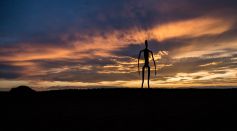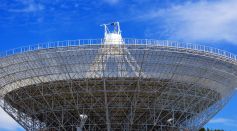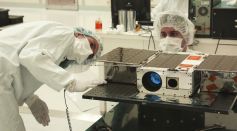Tags: Exoplanets
NASA Discovered "Hot Jupiter" Exoplanet, Bigger But Less Massive Than Solar System's Largest Planet
Earth Look-A-Like Detected: Spectrographs Developed to Detect Other Planets Similar to Ours

Four Newly Discovered Exoplanets Could Give Insights to Earth's Teenage Life
Earth's Atmosphere Seems to be 'Unique', No Other Exoplanets Could Compare
Did Radio Waves From Earth Reach More Than 1,700 Star Systems? Here's What Experts Say
Gaseous Planets Orbiting Bright Star Discovered: Citizen Scientists Finds Exoplanets With Sizes Like Neptune and Saturn
Life on Venus: Will NASA Make This Possible on Earth's Twin Planet?
Drastically Shrinking Planets Offer Hints Behind Mystery of Missing Worlds: What Causes This Phenomenon?
Red Dwarfs: Can Humans Live on Exoplanets Orbiting the Most Common and Long-Lasting Stars in the Galaxy?
Exoplanet Discovery: NASA's Hubble Space Telescope Witnesses Growing, Feeding Giant Planet
Robots are Being Taught to Autonomously Evolve to Survive in Distant Planets

Kepler Finds Triple-Star System With a Skewed Configuration
Kepler Space Telescope Reveals About 300 Million Habitable Planets Possibly Exist in the Milky Way
NASA Missions Find Survivor Planet Orbiting Remains of Dead Star

British Scientists Use AI to Identify New Planets
The Discovery of Star “cooking” Its Baby Planets Sheds Light on Finding Habitable Exoplanets in Space

Scientists Plan to Study Dead Stars and Exoplanets to Look for Fingerprints and Other Signs of Life

The Search for Extraterrestrial Intelligence Heightens

Earth-Like Exoplanet Discovered While Orbiting a Red Dwarf Star by NASA's TESS

NASA's Tiny Satellite ASTERIA is Lost in Space
Most Popular

Ocean Acidification, Marine pH Change, and CO2 Absorption: How Coral Reef Damage and Shellfish and Plankton Impacts Threaten Marine Life

Dark Matter Explained: What We Know, What We Don't, and How It Shapes Cosmic Structure

Memory and Learning: How the Brain Stores, Retrieves, and Forgets Information

Solar Storm Risks: How Geomagnetic Storms Threaten Earth's Power Grids and Satellites




